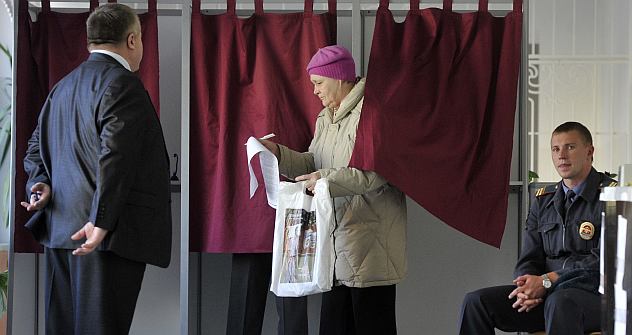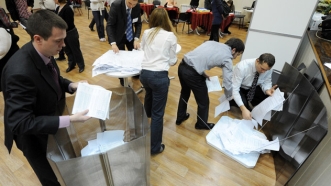No change after political reform

The Russian opposition showed low record during the recent regional elections because of the lack of unity and coherent political programs. Source: ITAR-TASS
Oct. 14 was “election day” in Russia. Elections at various levels were held in 77 constituent entities of the Russian Federation, of which six elected regional parliaments and five regions chose their governor for the first time in eight years. In total, more than 4,000 local elections and referenda took place.
The main novelties were the opportunity for reformed political parties to take part, as a result of the newly liberalized political law and the reduction in the minimum number of party members required for registration. In addition, the ruling United Russia party had a chance to test its innovations at the regional level, engaging with opposition candidates and garnering their support, thereby ensuring victory for their own protégés.
The election of regional governors by popular vote was abolished in 2004, when the nationwide plebiscite was replaced by a procedure that gave the president the right to install his own candidate in regional parliaments. The procedure was later modified: this time around, three possible candidates were presented to the head of state by the victorious party in the given region.
The new law gave rise to a trend that saw the mass resignation of elected governors who anticipated or hoped that the president would show faith in their abilities by reinstating them. As such, in the course of several years, all senior regional officials were reappointed.
This year, the body of governors decided to return to a system of popular voting, albeit with some revisions.Candidates in the electoral race are now nominated by political parties, and, to be eligible for registration, they must collect the signatures of 5-10 percent of all regional members of parliament and mayors (the exact threshold is set for each region individually).
The first regions to go through the electoral crucible were Belgorod, Novgorod, Amur, and Bryansk, where the terms of the existing governors had expired. Also among these was the Ryazan region, where the governor had prematurely resigned. In total, 21 candidates from nine parties were registered; all of the existing regional leaders were put forward by United Russia.
In Belgorod, Amur and Novgorod regions, United Russia's protégés were the initial favorites. In Ryazan Region, the not too popular incumbent Oleg Kovalev was up against renowned regional politician Igor Morozov, whose candidacy was put forward by Patriots of Russia, an opposition party with no seats in the State Duma. However, shortly before the vote, the Patriots candidate withdrew in favor of Kovalev, who promised his former adversary a post as a federal senator.
The hottest campaign took place in Bryansk Region, where acting Governor Nikolai Denin was forced out of the running due to a lawsuit filed by the Communist candidate. Following this, other contenders from the LDPR (Liberal Democrat Party) and Yabloko (Apple) also ruled themselves out by stating their support for Denin. The election was under threat, since the ballot paper now contained only one name — Vadim Potomsky of the Communist Party. Nonetheless, the Supreme Court intervened and reinstated Denin.
The result of election day was the re-election of all incumbent governors: Oleg Kovalev (Ryazan Region), Nikolai Denin (Bryansk Region), Oleg Kozhemyak (Amur Region), Sergei Mitin (Novgorod Region), and Yevgeny Savchenko (Belgorod Region). All of United Russia's candidates fetched 65-78 percent of the vote. Following the announcement of the first results, the leaders of United Russia officially named as “partners” those opposition candidates and parties that withdrew from the race in favor of United Russia.
The collaborators were promised top positions, right up to deputy governor. United Russia secretary Sergei Neverov and State Duma deputy Vyacheslav Lysakov of United Russia agree that such partnerships are part of a “a new political trend.”
{***}
As for the new political parties, the regional elections involved 19 new organizations that registered with the Ministry of Justice. This was made possible by the reduction of the minimum number of members required — down from 40,000 to just 500. New parties included The Party of Social Networks, Union of Citizens, Smart Russia, and others.
The most notable performance was delivered by The Republican Party of Russia — People's Freedom Party (PARNAS), co-chaired by former State Duma deputy Vladimir Ryzhkov, in the Barnaul City Council election. The party gained almost 5.5 percent of the vote, breaking the threshold mark.
In an interview with RBTH, Vyacheslav Smirnov, director of the Institute of Political Sociology, drew attention to the elections in North Ossetia: Arsen Fadzaev, a former State Duma for United Russia and now Olympic champion, headed the list of candidates from Patriots of Russia and won more than 26 percent of the vote. In the city of Karachayevsk in Karachay-Cherkess Republic (nearly 1,000 miles from Moscow), the newly formed Communists of Russia party made it into the City Council with 8.54 percent of the vote, well ahead of the old-style Communist Party, which garnered just 8.08 percent.
“There was no triumphal procession of the newly created opposition. Even the lone Vladimir Ryzhkov of PARNAS passed the threshold, but, with no spare cash for his campaign, not by a huge margin. The Democratic Party of Russia, the Social Democratic Party, the Party of Social Networks, Cities of Russia, Smart Russia, the People's Party — they all just registered their lists, and half of them didn't even take advantage of the free airtime provided by the government,” said Smirnov.
According to the expert, “they had to take part at all costs, regardless of the outcome, to demonstrate to the authorities that they had not been set up in vain, that they were alive and functioning.”
“The problem, over and above a lack of funds and personnel, was the excessively ideologized campaigns of the liberal opposition, given that the left-of-center electorate in Russia is a mere 10 percent and always shows a low turnout at elections. The left-socialist electoral, representing about 25 percent, shows a higher turnout, albeit marginally. It seems that, wherever turnout is low, United Russia and the Communists accumulate more votes, while the intellectuals opt for A Just Russia or Yabloko,” Smirnov said.
Alexei Mukhin, general director of the Center for Political Information, places the blame for the electoral failure of the newfound opposition on staff crises within its ranks. “At the regional and municipal level, they put forward politicians. Maybe that would work for elections to the State Duma, but, on the ground, administrators are needed, which new parties don't have,” said the political scientist in an interview RBTH.
In Mukhin’s opinion, the new parties need to be institutionalized to avoid the existing chaos: “They have announced themselves, but not yet proved their worth. Protest leaders have made an impression on the authorities, but, out in the regions, action speaks louder than words. Their priority must be to solve the staffing issue; then, at the next election, they might put in a decent performance.”
All rights reserved by Rossiyskaya Gazeta.
Subscribe
to our newsletter!
Get the week's best stories straight to your inbox
